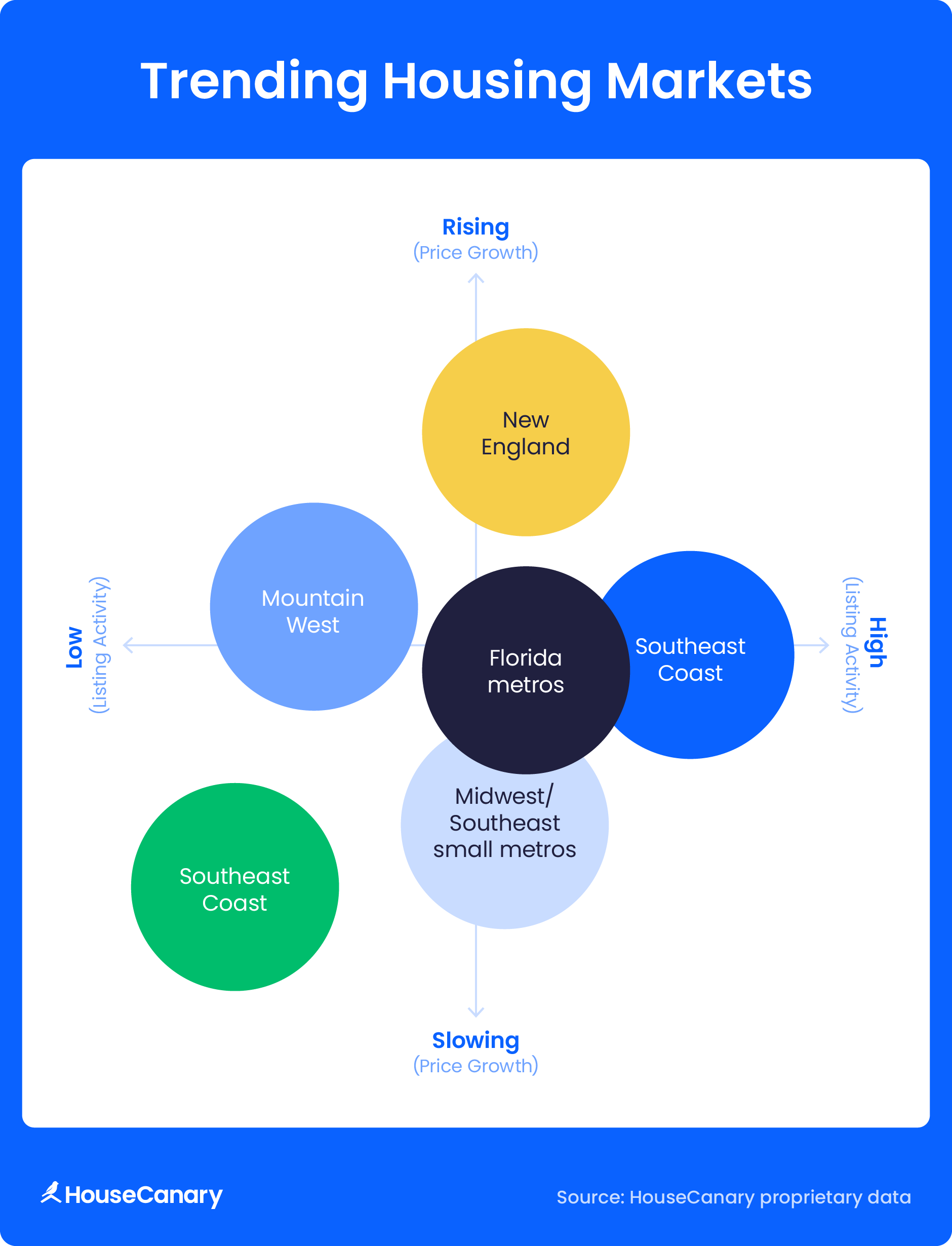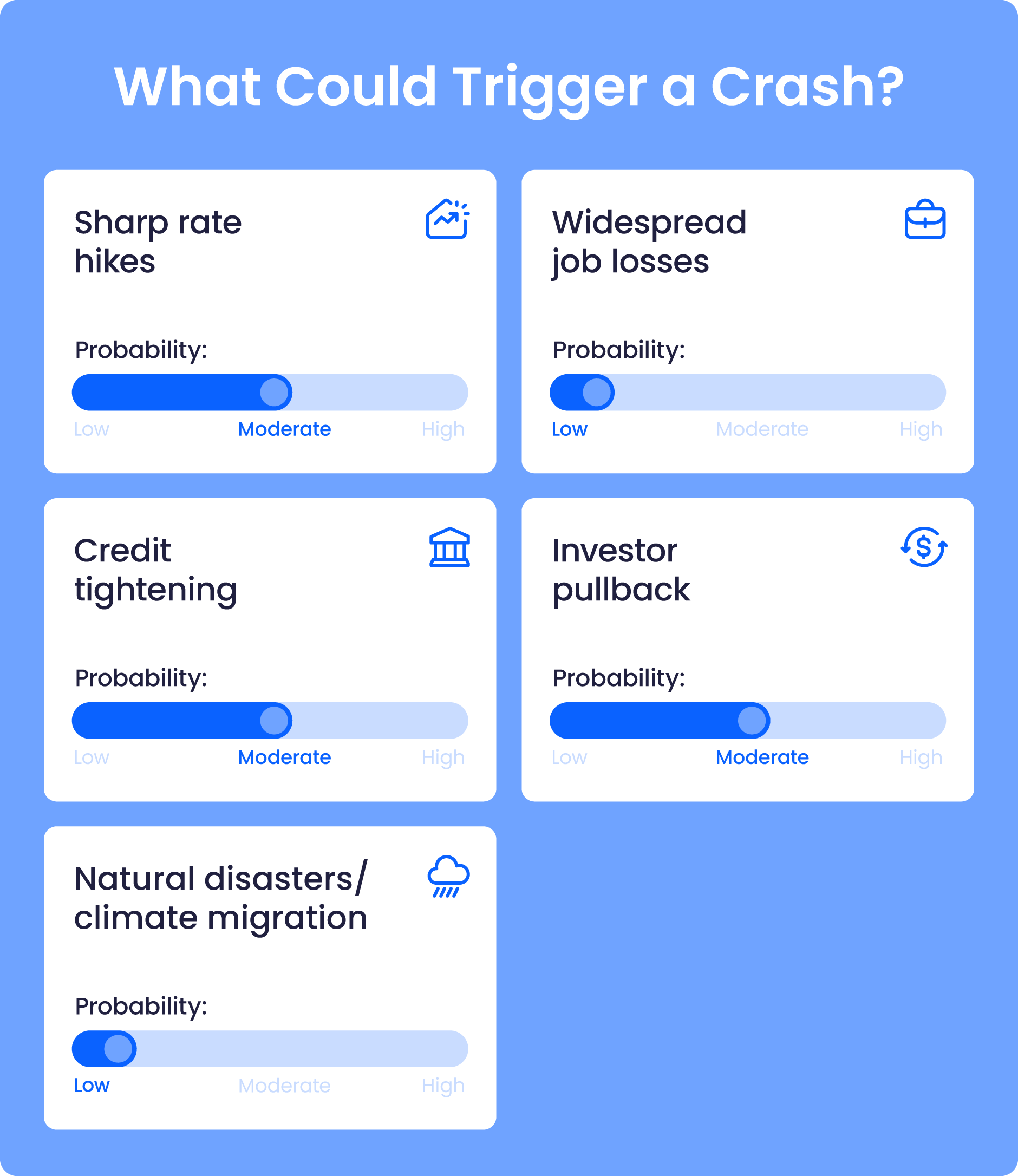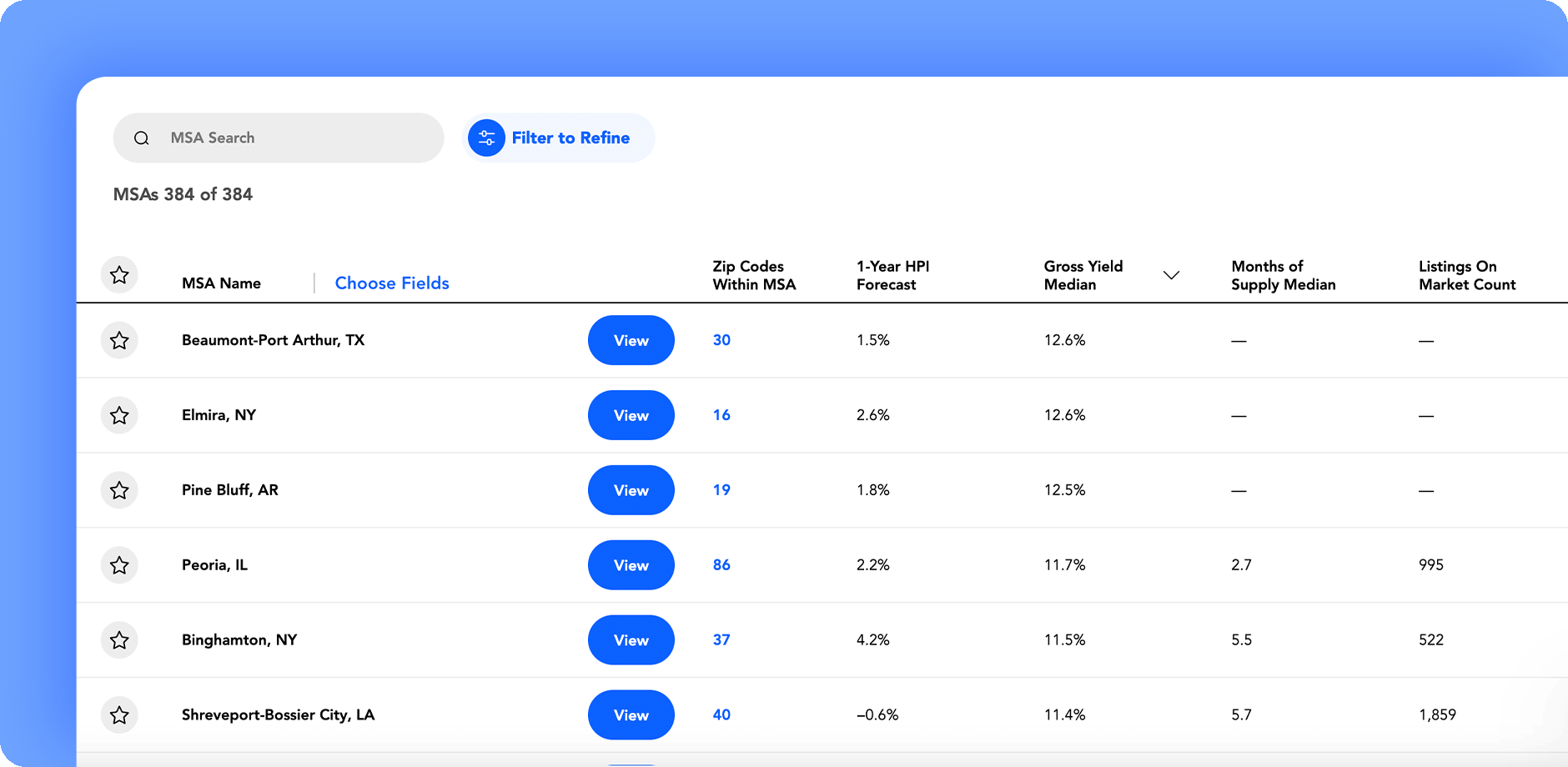
Talk of a housing crash is making headlines again, but is there real cause for alarm in 2025? A 2008-style housing crash is unlikely according to HouseCanary’s housing market predictions, but that doesn’t mean the market is in the clear.
High mortgage rates and affordability pressures are weighing heavily on buyers, and regional slowdowns are emerging across the country. Investors, agents, and homeowners are asking: Is the housing market going to crash or just cool off?
Experts say it’s a market to watch closely, not one to abandon. With the right data, there’s still room for investors to profit and for buyers to make smart moves.
Key Takeaways
- High inventory growth signals a shift toward balance: States like Florida’s housing market shows inventory more than doubling since early 2022, pointing to a market correction rather than a crash.
- A 2008-style crash is unlikely: Lending standards remain tight, foreclosure rates are low, and current economic conditions don’t mirror the risk factors that led to the last major crash.
- Regional differences matter more than ever: Markets like Florida, Utah, and coastal Southeast states are experiencing high turnover and remain strong in listing activity, while others are cooling, emphasizing the need for local-level insights.
- Home price growth is slowing, not reversing: After years of rapid appreciation, price growth is tapering off in many regions. This moderation signals a healthier, more sustainable market rather than an impending collapse.
Is the Housing Market Going to Crash in 2025?
Despite ongoing uncertainty, most experts agree that a full-blown housing crash in 2025 is unlikely. The conditions that caused the 2008 collapse (loose lending practices, high-risk loans, and a flood of foreclosures) aren't present in today's market.
Instead, the current real estate housing market faces a very different set of challenges: limited inventory, high mortgage rates, and widespread affordability concerns. While some regions may experience price flattening or slight declines, this pattern aligns more with a market correction than a crash.
The real estate cycle naturally includes corrections, which often stabilize overheated markets. In many cities, home prices surged rapidly during the pandemic, and a cooling period is both expected and necessary to balance the market. As conditions shift, data becomes even more critical. Strong data helps investors evaluate which markets are cooling, which remain competitive, and where opportunities still exist.
A Look at Recent Market Trends
Over the past several years, the U.S. housing market has experienced significant changes. Early on, record-low mortgage rates and strong buyer demand led to rapid price growth and limited inventory in many parts of the country. Investor activity also surged during this time, further tightening supply in key markets.
Several market indicators point to a cooling, but not crashing, market:
- Inventory is rising: In states like Florida, active listings more than doubled from around 56,000 in early 2022 to over 130,000 by Q2 2025, based on data from HouseCanary’s Market Insights. Texas and California have seen similar increases.
- Price growth is slowing: After years of rapid appreciation, many markets are seeing flattening or modest price gains, especially in overvalued metros.
- Days on market are increasing: Homes are taking longer to sell, giving buyers more negotiating power and reducing urgency.
- Affordability pressures persist: Higher mortgage rates and inflation continue to weigh on buyer budgets, limiting demand in some regions.
- Regional variation is widening: While some areas (especially parts of the Southeast and Mountain West) remain competitive, others are clearly cooling.
These shifts suggest the market is moving toward a more balanced state rather than heading for a crash. By tracking these current real estate market trends at both the national and local levels, investors and agents can find the best markets for investment.

Key Indicators to Watch in 2025
As the housing market continues to shift, several indicators will be especially important to watch. Watch these data points for early signals about where the market is headed:
- Inventory levels: Rising inventory in many states means more choices for buyers and less competition per listing. For investors, this may signal better entry points, more room to negotiate, and a shift away from bidding wars that inflated prices in recent years.
- Slowed price growth: While home values are still rising in some areas, the pace has slowed significantly compared to 2020-2022. This trend may reduce short-term appreciation potential, but it can create more stable investment environments and reduce the risk of overpaying in overheated markets.
- Strict lending standards: Mortgage lenders continue to apply conservative approval standards. This limits the buyer pool, especially among first-time buyers, and may suppress demand in lower-priced segments, giving investors with cash or strong financing an edge.
- Foreclosures: While still below historical averages, foreclosure filings are gradually increasing in some regions. A sharp uptick, especially above pre-2019 averages, could indicate growing financial strain and rising inventory. Investors can watch for pockets of distress as potential acquisition opportunities.
- Rising interest rates: Mortgage rates near 7% have already softened buyer demand. If rates continue to climb or remain elevated through late 2025, affordability will remain a major constraint, especially in high-cost metros. This may pressure home prices, but can also increase demand for rentals as would-be buyers delay homeownership.
- Unemployment and economic stability: Job growth, wage trends, and consumer confidence all influence housing demand. Investors should watch for shifts in local employment data.
Closely monitoring these trends can help participants better anticipate changes and evaluate property values for success in 2025.
Regional Hotspots to Watch in 2025
Several key hotspots are shaping the market this year. According to HouseCanary’s data, these regions stand out:
- Florida metros dominate: Areas like Punta Gorda and Cape Coral-Fort Myers lead the nation in listing activity, driven by retiree demand, migration trends, and seasonal turnover.
- Mountain West markets are thriving: Metros such as St. George, UT, and several in Colorado show strong listing activity fueled by lifestyle appeal and population growth.
- Desert markets remain active: Arizona and Nevada metros continue to see movement, though rising inventory may temper future price growth.
- Southeast coastal cities show momentum: Places like Hilton Head, SC, and Jacksonville, NC, offer dynamic turnover and steady price appreciation.
- Smaller Midwest and Southeast metros are gaining ground: These markets show strong price growth and affordability, making them appealing for long-term investors.
These regional trends highlight where sellers are most active and where buyers and investors can find promising opportunities in 2025.

What the Experts Are Saying
Chris Stroud, Chief of Research at HouseCanary, highlights some trends to watch.
"Inventory is increasing back to pre-COVID levels in most markets, but remains low from a historical perspective. Foreclosures and mortgage defaults remain near historical lows, and the job market remains strong.
Home price growth is pressured due to increasing inventory as well as record-high prices and elevated interest rates. From a national perspective, we expect home prices to increase moderately. There will be quite a bit of variation in home price growth as you dig down into the individual market level, with some markets experiencing price declines in 2025."
—Chris Stroud, Chief of Research
Platforms like CanaryAI, which leverages a massive 136+ million property dataset and industry-leading analytics, can help you stay ahead of these market trends and keep up with expert recommendations.
Should You Buy, Sell, or Wait?
Deciding whether to buy, sell, or wait depends on your unique goals and the current market conditions. Here’s what each type of buyer or seller should consider:
- First-time buyers: With increased listing activity in key markets, now is a good time to explore options. Rising inventory in some regions offers more choices, but expect competition in popular areas.
- Investors: Focus on markets with healthy listing turnover and price appreciation, such as Colorado and Nevada. These regions balance rising inventory with solid demand.
- Sellers: In high-turnover areas like Florida and parts of the Mountain West, sellers may benefit from strong buyer demand. However, with rising inventory in some markets, strategic pricing is crucial to stay competitive.
What Could Trigger a Crash (and How Likely Are These Events)?
Even if a housing crash isn’t on the immediate horizon, subtle shifts can add up quickly. An overheated local market, rapid investor retreat, or unanticipated policy change could tip the balance in certain regions.
Climate trends also have an impact, prompting migration out of risk-prone areas and reshaping demand. While most experts don’t predict a sharp nationwide decline, staying proactive with localized, real-time data is the best way to reduce uncertainty and avoid surprises.

Tips to Prepare for a Potential Crash
While no one can perfectly predict a crash, smart preparation can protect your finances and give you an edge. Here are a few proactive steps to take:
- Build equity, not risk: Avoid overleveraging and choose properties you can comfortably afford.
- Stress-test your finances: Make sure you can survive higher rates, vacancies, or market dips.
- Watch local data closely: Use AI tools like HouseCanary to monitor local trends in real time.
- Lock in financing early: Secure favorable loan terms while they’re available.
- Keep an exit strategy in mind: Decide whether you should rent, hold, or sell if the market shifts suddenly.
Even in an uncertain market, being data-informed and prepared gives you options.

Stay Ahead of a Changing Real Estate Market
In an environment where conditions vary dramatically by region, it’s essential to ground your decisions in reliable data. Tracking key indicators like home price trends, inventory shifts, and mortgage rates can help you stay informed and act strategically.
Whether you’re buying, selling, or investing, being regionally aware and using tools like HouseCanary’s market insights gives you the clarity to move with confidence. These insights break down metrics like listing volume, median price per square foot, days on market, and price growth trends at the ZIP code level, offering a local view of market dynamics.
So, is the housing market going to crash? Probably not, but it is evolving. Sign up for HouseCanary today to stay ahead of the competition and monitor this evolution.














.jpeg)








